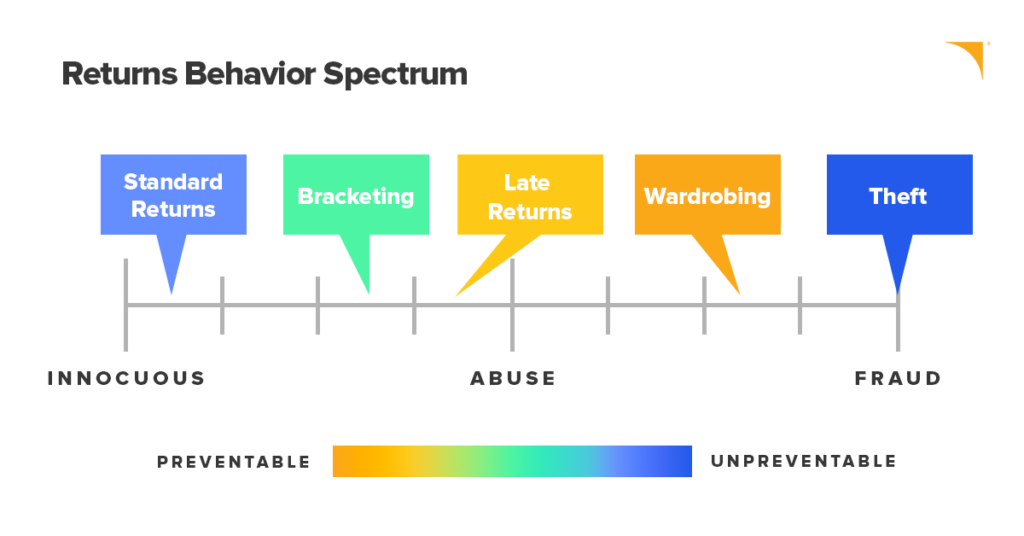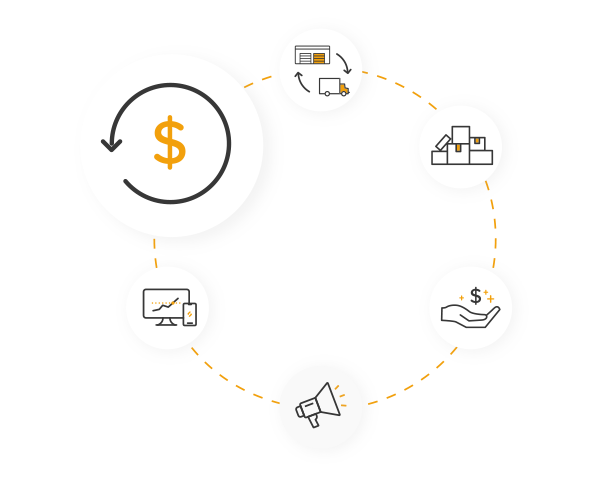There is often one (unwanted) elephant in the room when it comes to retail — returns. Whether a shopper is returning a perfectly-resalable item or exchanging it for a different size or color, the cost to facilitate and process returns can crush margins for retailers and brands. And while many brands historically considered returns merely a cost of doing business, studies now show that returns have become a top challenge to solve.
And as ecommerce sales remain steady and shoppers become more savvy, there is a new threat expanding — returns fraud. According to the National Retail Federation (NRF) returns fraud cost retailers $101.91 billion, up 20.0% year-over-year (YoY), and predictions that as high as 13% of returns will be fraudulent, across both brick-and-mortar and ecommerce.
Understanding the variety of returns behaviors that span the spectrum from innocuous returns to intentional fraudulent activities and everything in between is a necessary step to addressing the challenges. Once understood, you are equipped to take necessary and cost-saving measures mitigating returns loss while maintaining desired customer service. In the expensive returns challenge of today’s retailers, returns prevention is not the goal; fraudulent returns prevention is. In fact, healthy returners are 4 times more profitable than non-returners.
In this article we’ll look at:
The Spectrum of Return Behaviors: From Innocuous, to Abuse, to Fraud
While returns are certainly not retailers favorite topic, the reality is that a very small percentage of returners are bad actors with intentionally fraudulent behavior. So what are the various flavors of returns? To frame the conversation, retailers can think about returns in the broadest sense by looking at a few main categories for returns:

Innocuous Returns
Harmless returns that are part of the normal course of shopping for average shoppers and accepted (or at least accounted for) on the retailer’s side as an expected function of business.
Abusive Returns
Returns behaviors that are an abuse of return policies. Abuse occurs when shoppers take advantage of a retailer’s flexible returns policy to such an extent that it becomes unprofitable to the business. For example, keeping a product until the last day of a 30-day return window to then return/repurchase it at a lower price point, would be an abuse of the policy. Bracketing, as we explain later, can be construed as abusive behavior. These behaviors are not innocuous, and are likely not intentionally fraudulent. Abusive returns behavior are a fluid category on the spectrum and should be treated with care.
Fraudulent Returns
More retailers are beginning to differentiate fraudulent returns because they are somewhat “in between” what is preventable and unpreventable. There will most likely always be some element of malicious behaviors, but there are some things retailers and brands can do to identify bad actors and adapt future strategies to mitigate risk.
Along this spectrum, we find clear-cut examples and more gray-area ones. However you feel about it, whether you want to categorize abuse aggressively or not, only when you are recognizing it in your spectrum–and in your returns management system– can you take control of its loss/profit on the ledger.
Types of Returns Fraud & Abuse
Bracketing
Bracketing is an increasingly common practice where shoppers will purchase multiple sizes of the same item with the “intent to return” at least one of them. In fact, in 2022 63% of consumers admitted to bracketing, up 5% from previous years according to Statista. The practice is particularly prevalent amongst younger shoppers and is practiced more often with online purchases than in-store ones.
Is Bracketing Returns Fraud?
Short answer – No. Long answer – It’s complicated!
While bracketing isn’t inherently fraudulent, it does come at a cost to the retailer. Not only is the shopper “holding” otherwise available-to-sell inventory (potential loss of future sales), but they are also adding transportation, processing, and restocking costs for the retailer. In this vein, it’s appropriate to identify bracketing as an abuse in the spectrum of challenges retailers face with returns. While it is perfectly acceptable for shoppers to occasionally bracket their purchases (Optoro’s Returns Unwrapped report in late 2023 found that 28% of shoppers report bracketing only around major life events like weddings or graduations), retailers are starting to invest in technology that can flag customers who are susceptible to recurrent bracketing. Even now, Amazon flags certain accounts that have higher-than-usual return rates, meaning other retailers are likely to follow suit.
So in the spectrum of innocuous to fraudulent returns, we find bracketing to be more an abuse of returns rather than fraudulent. Another way for retailers to mitigate bracketing is to invest in “try before you buy” services and/or technologies. Mitigating bracketing at the sale step is surely an preemptive approach for reducing returns.
Wardrobing
Perhaps a seemingly innocuous shopping behavior is purchasing an item for a special event, and then returning the used item, also known as wardrobing. In this scenario, the shopper returns used, but non-defective inventory. In Optoro’s Returns Unwrapped Shopper Survey, we found that as high as 30% of shoppers admitted to wardrobing, and that shoppers between the ages of 18-29 are more likely to wardrobe.
And NRF found that nearly half (49%) of retailers say they have experienced shoppers returning used, non-defective merchandise (a la wardrobing) in the last year— the largest know returns fraud challenge at hand.
However, returning used items is in fact a milder form of returns abuse and can negatively impact both the (next) shopper’s experience as well as the brand’s reputation.
This is one reason that more retailers are investing in technology such as a returns management system (RMS), that connects the front-end returns experience to the back-end operational processing of returns. If retailers can connect (and validate) the return reason to the final grading and disposition, they can determine what items may need certain value-added services (VAS) before resale as well as flag shoppers that wardrobe orders.
This is one reason that more retailers are investing in technology such as a returns management system (RMS), that connects the front-end returns experience to the back-end operational processing of returns. If retailers can connect (and validate) the return reason to the final grading and disposition, they can determine what items may need certain value-added services (VAS) before resale as well as flag shoppers that wardrobe orders.
Returning Stolen Merchandise
Another form of returns fraud is when shoppers return stolen merchandise — whether shoplifted from a store or potentially via porch piracy, where an ecommerce order is stolen from a doorstep. According to NRF, 44% of retailers cited the return of shoplifted or stolen merchandise in 2023, indicating a growing need for tying order and customer data to returns and marking “gift” orders where possible.
Returning Fake or Knock-off Merchandise
In the luxury and high-end retail space, some retailers are experiencing fraud in the form of fake items being returned. A fraudster may purchase an item (whether online or in-store), swap the item for a knock-off version, and attempt to return it.
While this type of fraud may apply to a smaller niche than others, luxury retailers should have automated processing to test, grade, and verify the authenticity of returned merchandise — whether in the store or distribution center. Sometimes this check-and-balance is left to paper processes, or even worse, tribal knowledge from associates putting retailers at risk for shrink and loss.
Returning Miscellaneous Items
Some bad actors will attempt to initiate a return, keep the item, and return an unrelated item instead. For example, the Wall Street Journal noted that some retailers received a box of bricks in a flatscreen TV’s box instead of the TV, tissues instead of a t-shirt, and a box of hand sanitizers instead of sneakers (yes, really).
In this type of fraud, dishonest shoppers are assuming that the warehouse associates processing the return will lack the ability to flag the exception, and the ability to alert the retailer that the return is fraudulent. Unfortunately, in most cases, the refund has been issued to the shopper already and they still have possession of the purchased item.
“Damage” Fraud
Some shoppers may claim that an item is damaged or defective, when in reality the item is in good condition. This can happen because an item is past the return window and the shopper wants a refund, or if a shopper is simply gaming the system.
“Damage” fraud is particularly insidious in that companies without methods of identifying potential bad actors can face shrink to “returnless refunds” or what we call customer keep at Optoro. Retailers can elect for customers to simply keep an item, oftentimes if the value is too low to warrant the shipping and processing expense, or if an item is too large and would require exorbitantly expensive freight to receive.
Purple, the online mattress retailer, asks shoppers to donate the mattress if they elect to return it, and require proof of donation before processing the refund. However, these types of exceptions can be cumbersome and tricky to manage without the right technology in place.
In The News
How Can Retailers Quell the $101B Storm of Returns Fraud and Abuse Without Disappointing Customers?
Hint: There is a fine line between habitual returners and fraud.

What can Retailers do about Returns Fraud?
While returns fraud may be increasing, there are strategic ways in which retailers can protect themselves (and their margins). When retailers think about curbing returns, the first thoughts go to the Return Policy. Of course, changing the return policy, adding fees for example, can definitely curb abuse. In fact, one study found that 37% of shoppers admit higher return fees will affect their return habits. That being said, policy alone can’t curb abuse, and certainly won’t curb intentional fraud as much. That’s where your returns process technology comes into play.
Fully appreciating the nuances in shopper returns behaviors is the only way to take control of your returns loss. Only when you recognize and categorize them into preventable or unpreventable returns can you tailor a return management system to mitigate its business cost.
What is the technological infrastructure that supports the lifecycle of a return at your company? How many softwares do you subscribe to? How many workflows have your documented in manuals to be implemented by hired talent? Do your automated systems, e.g. your WMS, seamlessly meet the manual work laborers must do? Is the transfer of information clean? These questions target your technology and operations but they also serve to understand how abuse and fraud can be substantially mitigated. Here is how:
Tie Front-end Data to Back-end Data with a Returns Management System
One of the biggest challenges of returns is that retailers often have disparate systems to manage the returns management process. They may have a front-end portal for shoppers to initiate returns that trigger certain actions in the order management system (OMS). Then when the return is received in a store or a facility, they use their warehouse management system (WMS) to process the return. While there may be some data interchange, the disconnected nature of the systems prohibits retailers from understanding the full picture of returns. (Read more on options for returns management)
Instead of stringing together multiple systems, software and manual workflows, retailers should utilize as much software consolidation as is possible. A returns management system that handles your returns lifecycle end-to-end is the best way to keep all the data true, in a singular location, trackable, and finally, useful. In the case of curbing returns abuse or fraud, retailers should have a singular (returns management) system that can tie return reason codes to final disposition status, and then update customer data and risk models accordingly.
In terms of returns fraud, this would help retailers flag the shopper who returns a box of bricks in lieu of a television and stop offering risk-free return options to that shopper.
Understand and segment customers by return behaviors
While segmenting is commonplace for outbound purchasing, not all retailers have the same practices in place for returns. Retailers need ways to collect data from returners and segment them according to returns behaviors, including fraudulent ones like wardrobing. This helps retailers understand more of the shopper base and build a returns policy that can still be appealing to shoppers while protecting themselves from serial or fraudulent returners.
Knowing who their customers are and where they fit allows retailers to reward loyal shoppers while mitigating the risk of bad actors.
Invest in fraud-prevention software
Fraud has been a part of retail for as long as retail has existed in traditional forms like shoplifting or using stolen credit cards for purchases. But with the surge in ecommerce, digital fraud has become more of a concern. Fraud software providers like Signifyd, Kount, and Riskified help prevent fraudulent orders to begin with, which in turn can reduce the number of fraudulent returns a retailer experiences.
Offer personalized, dynamic return options to mitigate risk without impacting loyal customers
Once a retailer has identified the segments of their shopper base— they can create a personalized returns experience. Like segmenting, this is something almost all retailers are thinking about for outbound purchases, but is often overlooked (or they lack the technology to do the same) for returns. For example, with a modern returns management system retailers and brands can identify risky customers and modify return policies, offers, and optionality to those shoppers.
A few examples of personalized returns experiences:
- Offer dynamic incentives based on shopper segments (i.e. Instant refunds or exchanges that ship immediately for low-risk shoppers, but require a credit card hold for exchanges for higher-risk shoppers)
- Offer dynamic policies based on segment (i.e. low-risk shopper gets a longer return window)
- Offer dynamic pricing options based on segment (i.e. offer free returns for low-risk shoppers or loyalty club members)
While returns fraud is a growing concern in the retail industry, there are creative strategies brands can use to curb risk without damaging the shopper experience. One of the most critical aspects of tackling returns fraud is to have the right technology, data, and processes to identify risk and provide tailored solutions to isolate risky shoppers while still curating a delightful shopper experience for the majority of shoppers. With regards to technology, the fewer you have in your technology stack, the better data can accumulate and get relayed onto the right teams. A technology that handles the whole of your returns lifecycle end-to-end from initiation to methods, and finally disposition will give you the best overview of your state of returns. Only once you have that overview is it that you can optimize and mitigate returns fraud.
